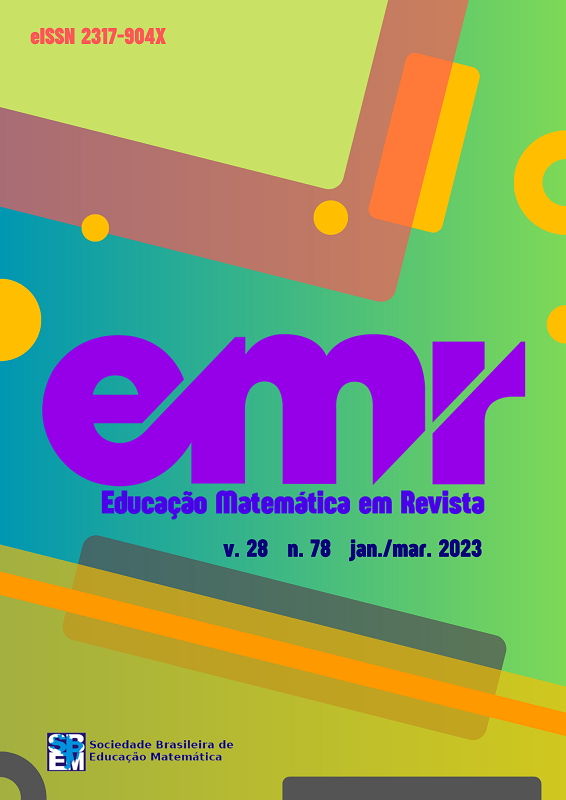Mathematics textbook: perspectives from High School teachers reports
DOI:
https://doi.org/10.37001/emr.v28i78.3191Keywords:
Mathematical education. , High School. , Textbooks.Abstract
In this article, we aimed to understand in which way mathematics high school teachers use textbooks in their teaching practice, as well as their perspectives on this resource. We sought to comprehend the teacher’s relationship with it, highlighting positive aspects and listing difficulties faced during the use of courseware. We also researched if the teachers made adaptations or used the materials exactly as they were proposed by the authors and publishers. To this end, four High School mathematics teachers who used textbooks approved by the National Textbook Program (Programa Nacional do Livro e do Material Didático – PNLD) in 2020 were interviewed. The data obtained were categorized through Discursive Textual Analysis. Four categories were built: LDM as a support tool, dependence on LDM, evaluation of LDM and modifications made by teachers in LDM. It is believed that the results that indicate its use as an important support for the teaching-learning process, sometimes a certain dependence on the LDM and the need for more radical changes in the content of the LDM, can contribute to those who dedicate themselves to the writing of teaching materials and to researchers interested in the topic.
Downloads
References
ABUD, K. M. A história de cada dia: saber escolar e saber acadêmico na sala de aula. In: MONTEIRO, A. M.; GASPARELLO, A. M.; MAGALHÃES, M. de S. (org.). Ensino de história: sujeitos, saberes e práticas. Rio de Janeiro: Mauad X, 2007.
BROWN, M. W. The teacher-tool relationship: theorizing the design and use of curriculum materials. In: REMILLARD, J. T.; HERBEL-EISENMANN, B. A.; LLOYD, G. M. (ed.). Mathematics teachers at work: connecting curriculum materials and classroom instruction. London: Routledge, 2009.
BROWN, M.; EDELSON, D. C. Teaching as design: can we better understand the ways in which teachers use materials so we can better design materials to support their changes in practice? Design Brief. Evanston, IL: The Center for Learning Technologies in Urban Schools, 2003.
COSTA, E. X. da. Narrativas de professores alfabetizadores sobre o Pnaic de alfabetização matemática. 2016. 259 f. Dissertação (Mestrado em Educação Matemática) – Programa de Pós-Graduação em Ensino de Ciências e Matemática, Universidade Federal do Paraná, Curitiba, 2016.
FIORENTINI, D.; LORENZATO, S. Investigação em Educação Matemática: percursos teóricos e metodológicos. 2. ed. Campinas: Autores Associados, 2009. (Coleção Formação de professores).
FOUCAULT, M. Estética: literatura e pintura, música e cinema. v. III. Rio de Janeiro: Forense Universitária, 2009. (Coleção Ditos & Escritos).
FREITAS, N. K.; RODRIGUES, M. H. O livro didático ao longo do tempo: a forma do conteúdo. DAPesquisa, Florianópolis, v. 3, n. 5, p. 300-307, 2008.
FURONI, S. P. Conhecimentos mobilizados por professores de Matemática do Ensino Médio em suas relações com livros didáticos. 2014. 155 f. Dissertação (Mestrado em Educação Matemática) – Instituto de Matemática, Universidade Federal de Mato Grosso do Sul, Campo Grande, 2014.
GOLDENBERG, M. A arte de pesquisar: como fazer pesquisa qualitativa em Ciências Sociais. São Paulo: Record, 2004.
JULIA, D. A cultura escolar como objeto histórico. Revista Brasileira de História da Educação, Campinas, n. 1, jan./jun., p. 9-43, 2001.
MORAES, R.; GALIAZZI, M. do C. Análise Textual Discursiva: processo reconstrutivo de múltiplas faces. Ciência & Educação, Bauru, v. 12, n. 1, p. 117-128, 2006.
SOARES, M. O livro didático e a escolarização da leitura. 7 out. 2002. Entrevista. DisponÃvel em: http://entrevistasbrasil.blogspot.com/2008/10/magda-soares-o-livro-didtico-e.html. Acesso em: 15 maio 2022.
Published
How to Cite
Issue
Section

This work is licensed under a Creative Commons Attribution-NonCommercial-ShareAlike 4.0 International License.






